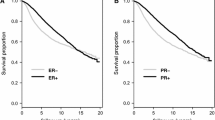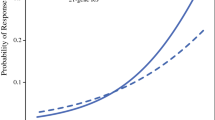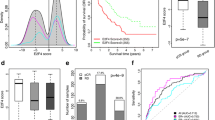Abstract
Purpose
Neoadjuvant endocrine therapy (NAET) for estrogen receptor-positive primary breast cancer causes adequate tumor shrinkage, and is expected to be helpful for breast-conserving surgery, but the adaptation criteria, especially in regard to treatment duration, have never been elucidated. Re-visiting past gene expression profiles, we explored the data for specialized pre-therapeutic predictors and validated the results using our in-house clinical cohorts.
Methods
We sorted the genes related to a > 30% tumor volume reduction through NAET from a cDNA microarray data-set of GSE20181, then selected the top 40 genes. We validated these gene expression levels using pre-therapeutic biopsy samples obtained from patients treated with long-term NAET (over 4 months; N = 40). A short-term (2–8 weeks; N = 37) NAET cohort was also validated to clarify whether expression of these genes is also related to a rapid response of Ki67 and PEPI score.
Results
In the long-term group, higher expression of KRAS, CUL2, FAM13A, ADCK2, and LILRA2 was significantly associated with tumor shrinkage, and KRAS, MMS19, and IVD were related to lower PEPI score (≤ 3). Meanwhile in the short-term group, none of these genes except CUL2 showed a direct correlation with Ki67 reduction or PEPI score. This suggested that tumor shrinkage by NAET might be induced by response to the hypoxic environment (CUL2, FAM13A, KRAS) and activation of tumor immune system (LILRA2), without involving inhibition of proliferation.
Conclusion
Expression of specific genes may allow selection of the most responsive patients for maximum tumor shrinkage with NAET.


Similar content being viewed by others
References
Semiglazov VF, Semiglazov VV, Dashyan GA et al (2007) Phase 2 randomized trial of primary endocrine therapy versus chemotherapy in postmenopausal patients with estrogen receptor-positive breast cancer. Cancer 110(2):244–254
Alba E, Calvo L, Albanell J et al (2012) Chemotherapy (CT) and hormonotherapy (HT) as neoadjuvant treatment in luminal breast cancer patients: results from the GEICAM/2006-03, a multicenter, randomized, phase-II study. Ann Oncol 23(12):3069–3074
Cataliotti L, Buzdar AU, Noguchi S et al (2006) Comparison of anastrozole versus tamoxifen as preoperative therapy in postmenopausal women with hormone receptor-positive breast cancer: the Pre-Operative “Arimidex” Compared to Tamoxifen (PROACT) trial. Cancer 106(10):2095–2103
Iwase H (2008) Current topics and perspectives on the use of aromatase inhibitors in the treatment of breast cancer. Breast Cancer 15(4):278–290
Ellis MJ, Tao Y, Luo J et al (2008) Outcome prediction for estrogen receptor-positive breast cancer based on postneoadjuvant endocrine therapy tumor characteristics. J Natl Cancer Inst 100(19):1380–1388
Dowsett M, Smith I, Robertson J et al (2011) Endocrine therapy, new biologicals, and new study designs for presurgical studies in breast cancer. J Natl Cancer Inst Monogr 2011(43):120–123
Dowsett M, Smith IE, Ebbs SR et al (2005) Short-term changes in Ki-67 during neoadjuvant treatment of primary breast cancer with anastrozole or tamoxifen alone or combined correlate with recurrence-free survival. Clin Cancer Res 11(2 Pt 2):951 s–8 s
Guerrero-zotano AL, Arteaga CL (2017) Neoadjuvant trials in ER breast cancer: a tool for acceleration of drug development and discovery. Cancer Discov 7(6):561–574
Fontein DB, Charehbili A, Nortier JW et al (2014) Efficacy of six month neoadjuvant endocrine therapy in postmenopausal, hormone receptor-positive breast cancer patients: a phase II trial. Eur J Cancer 50(13):2190–2200
Smith IE, Dowsett M, Ebbs SR et al (2005) Neoadjuvant treatment of postmenopausal breast cancer with anastrozole, tamoxifen, or both in combination: the Immediate Preoperative Anastrozole, Tamoxifen, or Combined with Tamoxifen (IMPACT) multicenter double-blind randomized trial. J Clin Oncol 23(22):5108–5116
Ueno T, Masuda N, Yamanaka T et al (2014) Evaluating the 21-gene assay Recurrence Score® as a predictor of clinical response to 24 weeks of neoadjuvant exemestane in estrogen receptor-positive breast cancer. Int J Clin Oncol 19(4):607–613
Ueno T, Saji S, Masuda N et al (2018) Impact of clinical response to neoadjuvant endocrine therapy on patient outcomes: a follow-up study of JFMC34-0601 multicentre prospective neoadjuvant endocrine trial. ESMO Open 3(2):e000314
Bedard PL, Singhal SK, Ignatiadis M et al (2011) Low residual proliferation after short-term letrozole therapy is an early predictive marker of response in high proliferative ER-positive breast cancer. Endocr Relat Cancer 18(6):721–730
Miller WR et al (2010) Changes in expression of oestrogen regulated and proliferation genes with neoadjuvant treatment highlight heterogeneity of clinical resistance to the aromatase inhibitor, letrozole. Breast Cancer Res 12(4):R52
Eisenhauer EA, Therasse P, Bogaerts J et al (2009) New response evaluation criteria in solid tumours: revised RECIST guideline (version 1.1). Eur J Cancer 45(2):228–247
Ibusuki M, Fu P, Yamamoto S et al (2013) Establishment of a standardized gene-expression analysis system using formalin-fixed, paraffin-embedded, breast cancer specimens. Breast Cancer 20(2):159–166
Dowsett M, Nielsen TO, A’hern R et al (2011) Assessment of Ki67 in breast cancer: recommendations from the International Ki67 in Breast Cancer working group. J Natl Cancer Inst 103(22):1656–1664
Toi M, Saji S, Masuda N et al (2011) Ki67 index changes, pathological response and clinical benefits in primary breast cancer patients treated with 24 weeks of aromatase inhibition. Cancer Sci 102(4):858–865
Fay MJ, Longo KA, Karathanasis GA et al (2003) Analysis of CUL-5 expression in breast epithelial cells, breast cancer cell lines, normal tissues and tumor tissues. Mol Cancer 2:40
Petrova V, Annicchiarico-petruzzelli M, Melino G, Amelio I (2018) The hypoxic tumour microenvironment. Oncogenesis 7(1):10
Ma CX, Reinert T, Chmielewska I, Ellis MJ (2015) Mechanisms of aromatase inhibitor resistance. Nat Rev Cancer 15(5):261–275
Generali D, Buffa FM, Berruti A et al (2009) Phosphorylated ERalpha, HIF-1alpha, and MAPK signaling as predictors of primary endocrine treatment response and resistance in patients with breast cancer. J Clin Oncol 27(2):227–234
Jia X, Hong Q, Lei L et al (2015) Basal and therapy-driven hypoxia-inducible factor-1α confers resistance to endocrine therapy in estrogen receptor-positive breast cancer. Oncotarget 6(11):8648–8662
Yamamoto Y, Ibusuki M, Okumura Y et al (2008) Hypoxia-inducible factor 1alpha is closely linked to an aggressive phenotype in breast cancer. Breast Cancer Res Treat 110(3):465–475
Jin Z, Chung JW, Mei W et al (2015) Regulation of nuclear-cytoplasmic shuttling and function of Family with sequence similarity 13, member A (Fam13a), by B56-containing PP2As and Akt. Mol Biol Cell 26(6):1160–1173
Jiang Z, Lao T, Qiu W et al (2016) A chronic obstructive pulmonary disease susceptibility gene, FAM13A, regulates protein stability of β-catenin. Am J Respir Crit Care Med 194(2):185–197
Eisenhut F, Heim L, Trump S et al (2017) FAM13A is associated with non-small cell lung cancer (NSCLC) progression and controls tumor cell proliferation and survival. Oncoimmunology 6(1):e1256526
Cejalvo JM, Pérez-Fidalgo JA, Ribas G et al (2016) Clinical implications of routine genomic mutation sequencing in PIK3CA/AKT1 and KRAS/NRAS/BRAF in metastatic breast cancer. Breast Cancer Res Treat 160(1):69–77
Karnoub AE, Weinberg RA (2008) Ras oncogenes: split personalities. Nat Rev Mol Cell Biol 9(7):517–531
Migliaccio A, Di Domenico M, Castoria G et al (1996) Tyrosine kinase/p21ras/MAP-kinase pathway activation by estradiol-receptor complex in MCF-7 cells. EMBO J 15(6):1292–1300
Jeng MH, Yue W, Eischeid A et al (2000) Role of MAP kinase in the enhanced cell proliferation of long term estrogen deprived human breast cancer cells. Breast Cancer Res Treat 62(3):167–175
Balko JM, Mayer IA, Sanders ME et al (2012) Discordant cellular response to presurgical letrozole in bilateral synchronous ER+ breast cancers with a KRAS mutation or FGFR1 gene amplification. Mol Cancer Ther 11(10):2301–2305
Lee DJ, Sieling PA, Ochoa MT et al (2007) LILRA2 activation inhibits dendritic cell differentiation and antigen presentation to T cells. J Immunol 179(12):8128–8136
Marchesi M, Andersson E, Villabona L et al (2013) HLA-dependent tumour development: a role for tumour associate macrophages? J Transl Med 11:247
Brough R, Frankum JR, Sims D et al (2011) Functional viability profiles of breast cancer. Cancer Discov 1(3):260–273
Dowsett M, Ebbs SR, Dixon JM et al (2005) Biomarker changes during neoadjuvant anastrozole, tamoxifen, or the combination: influence of hormonal status and HER-2 in breast cancer: a study from the IMPACT trialists. J Clin Oncol 23(11):2477–2492
Ueno T, Saji S, Sugimoto M et al (2016) Clinical significance of the expression of autophagy-associated marker, beclin 1, in breast cancer patients who received neoadjuvant endocrine therapy. BMC Cancer 16:230
Ellis MJ, Suman VJ, Hoog J et al (2011) Randomized phase II neoadjuvant comparison between letrozole, anastrozole, and exemestane for postmenopausal women with estrogen receptor-rich stage 2 to 3 breast cancer: clinical and biomarker outcomes and predictive value of the baseline PAM50-based intrinsic subtype-ACOSOG Z1031. J Clin Oncol 29(17):2342–2349
Funding
This study was founded by a Grant in Aid for Scientific Research from the Ministry of Education, Culture, Sports, Science and Technology of Japan (M. Ibusuki-Yamamoto, 25870539 and 15K21237).
Author information
Authors and Affiliations
Corresponding author
Ethics declarations
Conflict of interest
Y.Y has received fees for serving on advisory boards and a speaker honorarium from Astra Zeneca, Novartis, and Pfizer. L.G-Y, M.Y-I, Y.F, M.T, A.S, T.T and H.I declare that they have no conflict of interest.
Ethical approval
All procedures performed in studies involving human participants were in accordance with the ethical standards of the institutional and/or national research committee and with the 1964 Helsinki declaration and its later amendments or comparable ethical standards.
Informed consent
Informed consent was obtained from all individual participants included in the study.
Electronic supplementary material
Below is the link to the electronic supplementary material.
Rights and permissions
About this article
Cite this article
Goto-Yamaguchi, L., Yamamoto-Ibusuki, M., Yamamoto, Y. et al. Therapeutic predictors of neoadjuvant endocrine therapy response in estrogen receptor-positive breast cancer with reference to optimal gene expression profiling. Breast Cancer Res Treat 172, 353–362 (2018). https://doi.org/10.1007/s10549-018-4933-5
Received:
Accepted:
Published:
Issue Date:
DOI: https://doi.org/10.1007/s10549-018-4933-5




